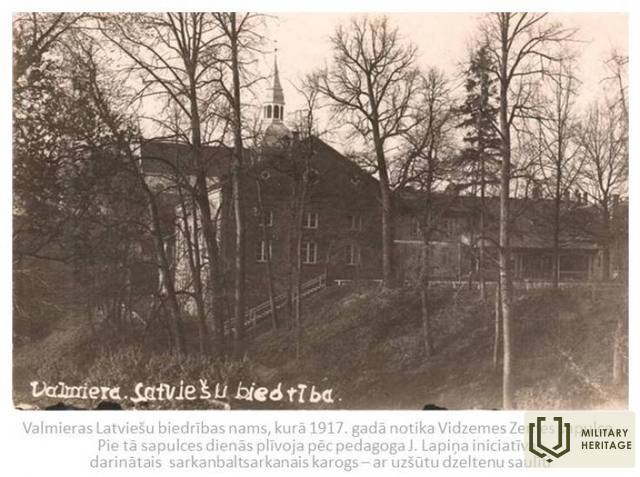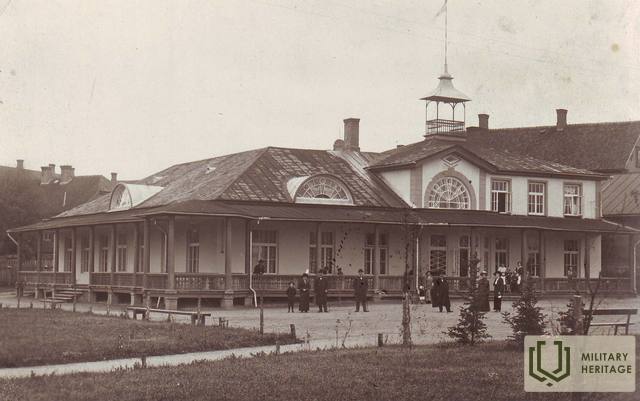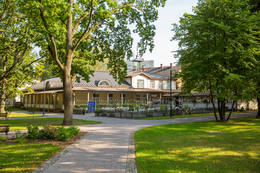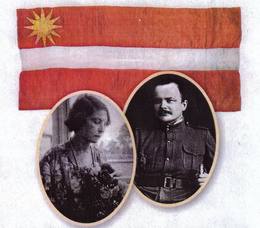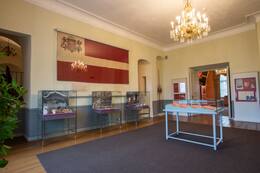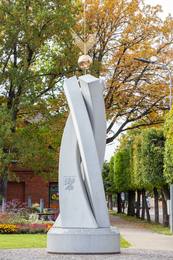March 1917 - an important month in the history of Valmiera and Latvia
In March 1917, more than a year before the proclamation of the state of Latvia, the Vidzeme Provisional Land Council was founded in Valmiera, which adopted a resolution on the autonomy and self-determination rights of Latvia. On the day of the founding of the Council, the red, white and red flag was raised for the first time at the meeting place.
On March 12 and 13 (March 25, 26), 1917, the Vidzeme Land Assembly was held. Representatives of local governments, cooperative associations, agricultural societies and landless people from the Riga, Cēsis, Valmiera and Valka districts gathered in Valmiera. Although the agenda included both political and economic issues, the real task of the assembly was to establish the Vidzeme Provisional Land Council. Agronomist Kārlis Ulmanis, the main speaker, emphasized the political goals to be achieved in the future. 17 resolutions were adopted, the most important of which was on the rights of autonomy and self-determination of Latvia.
Less than two years later, on the evening of November 17, 1918, in Riga, at the Suvorov Hotel, the Latvian People's Council was formed, and the Prime Minister of the Provisional Government of Latvia, Kārlis Ulmanis, was elected. The People's Council decided to perform the act of proclamation of the Latvian state at the Latvian Opera House (now the Latvian National Theatre).
The very next day, November 18, 1918, in Valmiera, Dr. Georgs Apinis requested permission from the German occupation authorities to hold a general meeting of the Valmiera Sports Association in the pavilion hall of the Old Boys' Park. G. Apinis' associates, who knew his true intentions, had secretly made a red-white-and-red flag and reproduced the texts "God, bless Latvia" and delivered them to the pavilion hall of the Old Boys' Park. Dr. G. Apinis announced the historical significance of this day to those present, while the participants solemnly promised to support the new state and its Provisional Government, headed by Kārlis Ulmanis. On this day, the national flag was raised for the first time in Valmiera as the state flag and the new national anthem "God, bless Latvia" was played for the first time.
Interestingly, the people of Valmiera were among the first to learn that the Latvian state had been founded. The day before, it had also been known at the Valmiera Real School, as evidenced by an entry in a student's diary on November 18, 1918 – "Due to the proclamation of the Latvian state, the last three classes will not take place." On November 18, the students of the Valmiera Real School also took a photo with red, white and red ribbons in front of the school.
Source: Valmiera Museum History Department
Related timeline
Related topics
Related objects
Stag Park and Concert Hall "Valmiera"
The park is located in the center of Valmiera.
In 1914, eight enterprising Valmiera residents decided to establish a park with a non-alcoholic buffet and a book table on the outskirts of the city at that time - thus began the history of the Vecpuiši Park.
The park's development work was interrupted by the First World War.
Already at the beginning of the war, a hospital for wounded soldiers was established in the pavilion hall. The second floor of the building housed the Valmiera Red Cross Committee, its central donation reception point, and a warehouse.
The Valmiera Committee was one of the most active in Latvia. In October 1914, it was in charge of 33 infirmaries with 375 beds. The Committee raised funds for the maintenance of infirmaries and the treatment of wounded soldiers, for the provision of warm linen and travel money to those who had recovered, for the feeding of wounded soldiers passing through, and also sent gifts directly to the front. One of the most active Red Cross Committee employees in fundraising was Kārlis Ulmanis (1877-1942), who later became the first Prime Minister of independent Latvia.
The history of the founding of the legendary Latvian rifle battalions is also connected with Vecpuiši Park. On August 4 and 5, 1915, a volunteer recruitment committee operated in the park, and on August 6, young soldiers were taken from here for training. Later, young men from Valmiera and the surrounding area were also taken from here many times as soldiers. During the war, various cultural and charity events were also held in the park, but all the funds raised were used to help those affected by the war.
On November 18, 1918, the national flag was raised for the first time in Valmiera as the state flag and the new national anthem “God, Bless Latvia” was played for the first time.
During World War II, the pavilion building of the Vecpuiši Park housed a hospital and riflemen were taken to battle. During the Soviet occupation, on August 12, 1940, by decision of the Valmiera City Board, the park was renamed Komsomol Park.
After World War II, the pavilion, designed by architect Freibergs, was used both as a cultural center (until 1966) and as a sports school. In the late nineties (1998), the pavilion in the Bachelor Park began to be active again.
The photographs displayed in the premises of the restaurant "Vecpuisis" show the founders of the park.
Memorial site of J. Lapiņš, the author of the first Latvian flag
Located in “Lejas Pintuļi”, Veselava parish, Priekuļi municipality.
A memorial to Jānis Lapiņš, the author of the Latvian flag, is visible.
The creation of the Latvian national flag took place during World War I. In 1915, when creating the flags of the Latvian rifle battalions, individual artists proposed red, white and red colors for the flag designs. After the design of the educator and journalist Jānis Lapiņš, the red, white and red flag was made in the second half of 1916 by his student, Marianna Straumane, a teacher at the Valmiera refugee shelter.
This is the first known and actually made Latvian national flag, which has survived to this day.
In 2014, a memorial site for the pre-flag author Jānis Lapiņš was opened in “Lejas Pintuļi” of Veselava parish, Priekuļi region.
The first known authentic Latvian national flag, which was smuggled into Russia and carefully hidden during the Soviet and German occupations, is currently kept in the Cēsis History and Art Museum . It was donated in 1997 by their daughter Lija Poga.
Cēsis history and art museum in the New Castle of Cēsis
The Cēsis History and Art Museum is located in the very centre of the Old Town of Cēsis, in the New Castle. The museum holds a permanent exhibit of history and interiors named ‘Cēsis, a Symbol of Latvian History’, with two thematic sections: the exhibit ‘Red-White-Red Flag in the History of Cēsis and Latvia’ explains the history of the Latvian national flag from the 13th to 20th centuries, the approved national symbol, the flags of Latvian rifle battalions and the traditions of using national colours during the Latvian War of Independence. The exhibit ‘Cēsis and the Latvian War of Independence’ focuses on the founding of the Cēsis Company in December 1918, the joint battle efforts of Estonians and Latvians in the 1919 Battles of Cēsis, the time when, during the Bermondt Affair, Cēsis served as the temporary capital of Latvia for a short time, as well as the history of the Cēsis Victory Monument. In an escape room named ‘Legends of the Battles of Cēsis’, the participants have one hour to find their way out by solving puzzles, making connections and finding hidden objects. The Cēsis Company, one of the first units of the Latvian Armed Forces, was established on 8 December 1918 in Cēsis Castle by Senior Lieutenant Artūrs Jansons. The museum’s exhibit features a memorial plaque dedicated to the Cēsis Company, unveiled on 8 December 1933 at the Cēsis New Castle, which, at the time, served as the headquarters of the 8th Daugavpils Infantry Regiment and the garrison officers’ club.
Monument "Dedication to the Latvian Provisional National Council"
The monument “Dedication to the Latvian Provisional National Council” is located in Valka at the intersection of Rīgas and Raina streets (address Raina street 9A).
The monument was unveiled on December 2, 2017, as part of Latvia's centennial program, in honor of the meeting of the Latvian Provisional National Council in 1917.
The author of the ensemble idea is the sculptor Arta Dumpe, the stonemason – Ivars Feldbergs, the architectural planning was carried out by SIA "Architectural Office Vecumnieks & Bērziņi".
The base of the monument is formed by a large millstone – like a circle of life, time and events. The names of the LPNP board members are engraved on its sides. From the millstone, like the paths of fate, three regions – Vidzeme, Kurzeme and Latgale with their historical coats of arms – rise up into the sky. The composition is concluded by the Bethlehem star, which transforms into the sun of the new Latvian state. Latvian poet, prose writer and politician Kārlis Skalbe /1879-1945/ wrote: “Latvia also had its own Bethlehem, little poor Valka...”.
The monument to the Latvian Provisional National Council is a kind of debt repayment to the people who, risking their lives in Valka in 1917, guided by ideals, laid the foundations of the Latvian state in a virtually impossible situation.
At that time, Valka was the city with the largest Latvian population in the territory not yet occupied by Germany. After the fall of Riga, it became the center of Latvian social, political and cultural life. Those who were united by the desire to implement the right of self-determination of the Latvian nation gathered here. From November 29 to December 2, 1917 (according to the new style), the 1st session of the Latvian Provisional National Council was held in the Valka City Hall (now the building at Kesk Street No. 11 in Valga), in which representatives of almost all the most influential Latvian public organizations and political parties participated. For the first time, they officially declared the goal of their activities - the creation of an independent national state, and adopted a declaration on the creation of a united and autonomous Latvia in the Latvian districts of Vidzeme, Kurzeme and Latgale.




